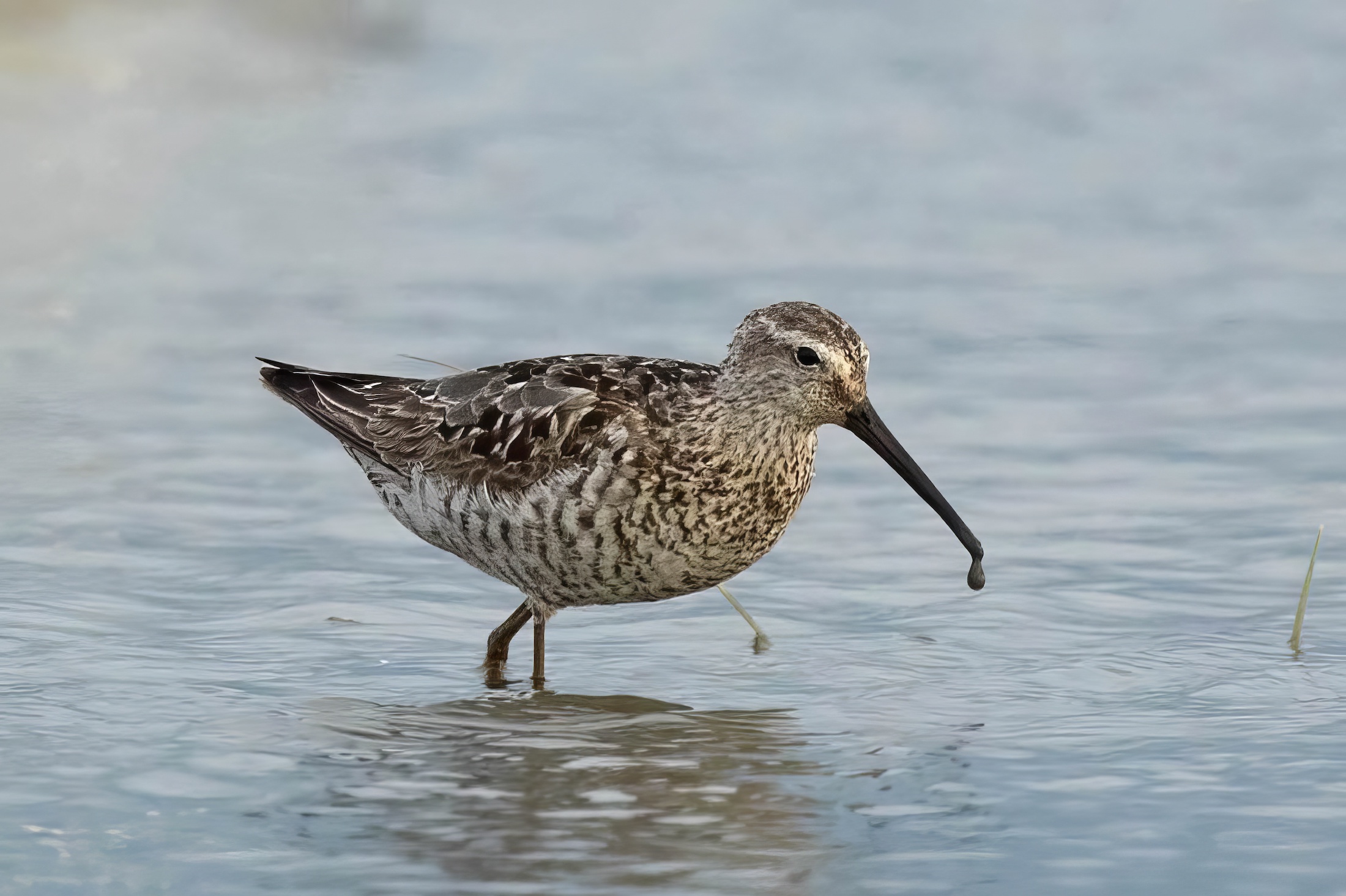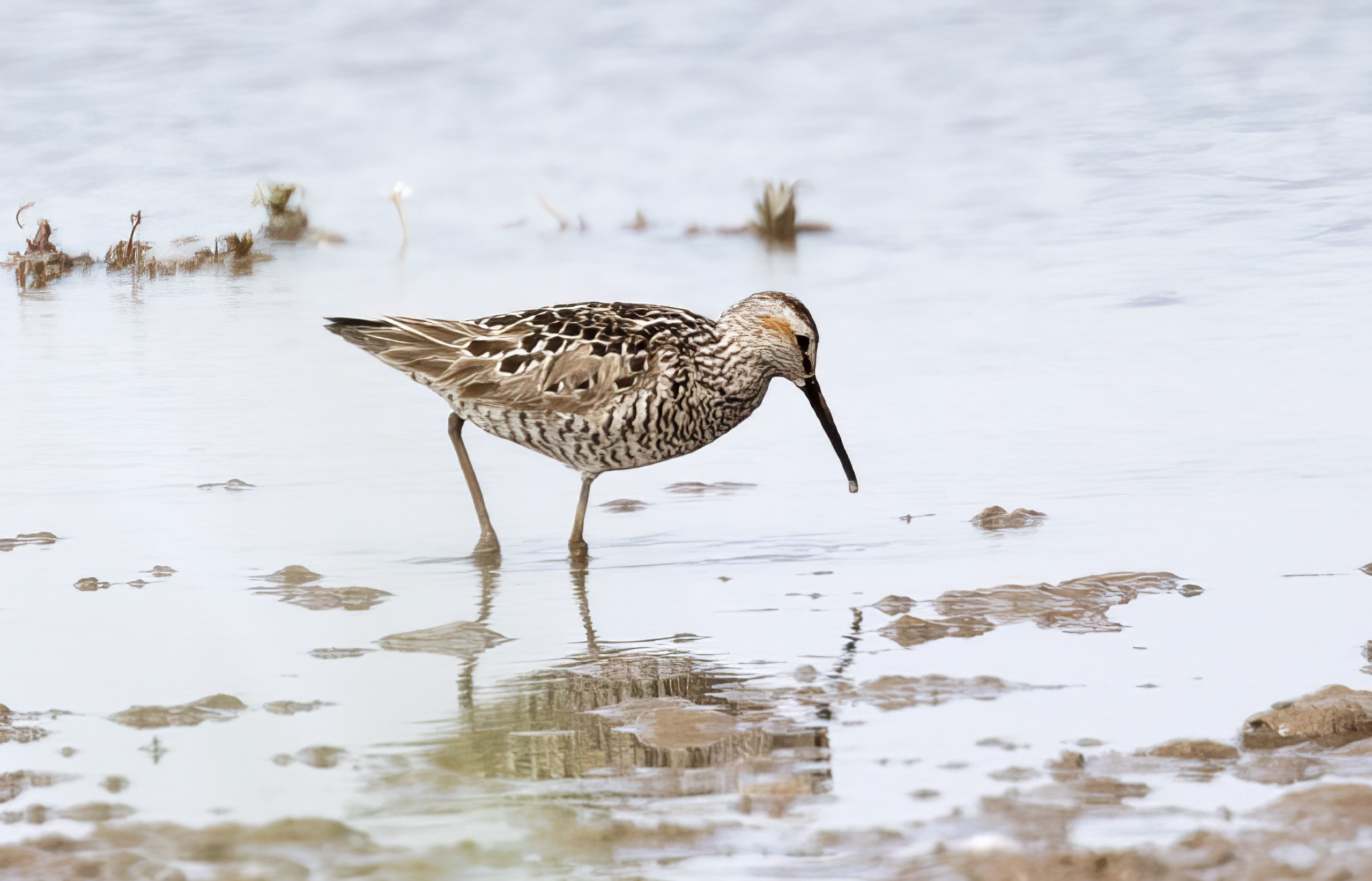Stilt Sandpiper Calidris himantopus


Stilt Sandpipers: left, Frampton Marsh August 23rd, 2018 (Paul Coombes) and right, Alkborough Flats July 17th 2022 (Graham Catley).
There have been four county records of this charismatic Arctic wader, two being in the 1960s at the shorebird magnet that was Wisbech Sewage Farm, and the two recent ones in 2018 and 2022 at the 'new' wetlands of Frampton Marsh and Alkborough Flats. The first individual was trapped before it had been seen in the field and as the finders noted “(it) could not readily be identified”, unsurprising given the field guide literature of the day. After release if flew to the muddy banks of the River Nene, just inside the Cambridgeshire border, and it remained in the area for nearly three weeks. The two subsequent county records were also of relatively long stayers, both remaining for around two weeks.
There have been 41 British records 1950-2022; it remains a rare shorebird with one record every 1-2 years. The latest record in any year was of one on Shetland on November 5th 2002; it was also the first confirmed British record of a juvenile. Although juveniles have occurred previously in Ireland, birds of this age class remain a true rarity in Europe. With most records relating to early autumn adults, often on the east coast, it is interesting to speculate that they may have crossed the Atlantic in previous years and are moving south with adult Pectoral and Curlew Sandpipers. At this season, east coast records outnumber those from other regions, supporting the idea that arrivals are coming from the north-east.
| Site | First date | Last date | Count | Notes |
| Wisbech STW | 19/07/1963 | 07/08/1963 | 1 | Adult SP, trapped |
| Wisbech STW | 12/08/1965 | 26/08/1965 | 1 | Adult SP |
| Frampton Marsh | 22/08/2018 | 03/09/2018 | 1 | Adult SP |
| Alkborough Flats | 15/07/2022 | 03/08/2022 | 1 | Adult SP |
Stilt Sandpiper on Lincoln/Norfolk/Cambridge borders: first Lincolnshire record.
By C. D. T. Minton.
Note: this account is © British Birds and appeared in the March 1964 edition. The first British record was in 1954 with another in 1962, then this one in 1963 when there was also a second bird in Sussex, August 7th.
Circumstances
At 11 p.m. on July 19th, 1963, a wader which could not readily be identified was caught in a mist-net at Wisbech sewage-farm, on the border of Lincolnshire and Norfolk. It had not previously been observed in the field. It was examined in the hand by Mr. and Mrs. J. A. Hardman, G. Gould, D. Stanyard, my wife and myself, and the following description taken:
Description
Upper-parts - crown dark brown with some white flecks; pronounced white stripe just over eye; buffish orange-brown ear-patch about 7.5 mm. across; dark brown patch connecting eye and base of bill; nape lighter than crown and mantle; mantle and scapulars dark brown with pale buffish-white edges to feathers, extensively abraded; rump white with some slight barring, particularly in centre; upper tail-coverts widely barred brown and white; tail dark fawn-brown (but lighter than mantle) with centres of individual feathers almost pure white; wings uniform brown except for small white tips to secondaries and secondary-coverts, most marked on innermost feathers; wing-coverts heavily abraded.
Underparts - from base of bill to under tail-coverts strongly barred brown, barring extremely heavy on upper breast.
Soft parts - bill slender, black, slightly downcurved at tip; legs long, olive-green, wrinkled, and scaly as in adult rather than juvenile bird.
Measurements - wings 135-136 mm., with 5th, 6th, and 7th primaries emarginated (and 4th slightly); bill 41.5 mm. to feathers, 49 mm. to base of skull, with down curve beginning 12 mm. from tip; tarsus 43 mm., tibia 30 mm. to feathers, feet projecting about 30 mm. beyond tail.
Further observations
The bird was not weighed but appeared to be fat and in excellent condition. It was photographed in colour and then released at 7 a.m. on 20th July 1963. The flight somewhat resembled that of a Snipe Gallinago gallinago and the contrast of white rump and dark wings was somewhere between a Green Sandpiper Tringa ochropus and a Wood Sandpiper T. glareola. The bird was subsequently observed feeding on the bank of the River Nene, just in Cambridgeshire, at a range of forty yards in good sunlight. The rapid feeding rate recalled that of a dowitcher Limnodromus sp. The general 'jizz' did not closely resemble that of any common British wader. The ear-patch was clearly visible in the field and the eye-stripe was most pronounced between the dark crown and the dark patch in front of the eye.
The description fits that of a Stilt Sandpiper Micropalama himantopus still largely in summer plumage. The abraded mantle and wings were typical of an adult wader in autumn. The good condition of the bird and the absence of strong westerly winds in the period immediately preceding the occurrence suggested that it had not recently crossed the Atlantic. It remained at Wisbech sewage-farm for nearly three weeks, during which time it was seen by a number of other observers, and it was last reported by R. Harrison and R. A. Richardson on 7th August.
Reference
Minton, C.D.T. (1964) Stilt Sandpiper on Lincoln/Norfolk/Cambridge borders. British Birds 57: 124-125.
(Account as per new Birds of Lincolnshire (2021), included September 2022; records updated to 2022)

